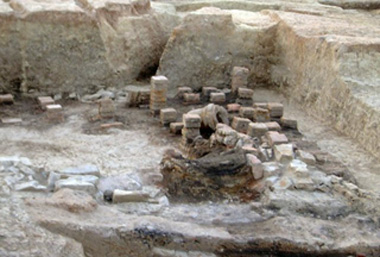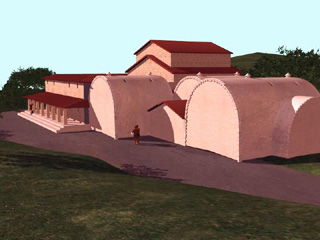 Dates are coming in for the pottery and
coins from Wigan’s bathhouse excavations and it’s looking like the site was
abandoned by the Romans in the middle of the 2nd century AD. This coincides with a
military advance into Scotland under emperor Antoninus Pius and the construction of the
Antonine Wall. Ian Miller from Oxford Archaeology North says that the assemblage,
particularly the amphora, is very military in character, and therefore fits well with the
expansion into Scotland, and the logistical support which would follow behind. Preliminary
archaeo-magnetic dates from the hypocaust stokehole, also support this theory, suggesting
that it was last fired around 140 AD. As we saw last month at Littlecote, the Romans like
to use under-floor heating for other buildings such as villas, but Ian can confirm that
this site was definitely a bathhouse, as the types of vessels being found suggest oils and
ointments were being used. Dates are coming in for the pottery and
coins from Wigan’s bathhouse excavations and it’s looking like the site was
abandoned by the Romans in the middle of the 2nd century AD. This coincides with a
military advance into Scotland under emperor Antoninus Pius and the construction of the
Antonine Wall. Ian Miller from Oxford Archaeology North says that the assemblage,
particularly the amphora, is very military in character, and therefore fits well with the
expansion into Scotland, and the logistical support which would follow behind. Preliminary
archaeo-magnetic dates from the hypocaust stokehole, also support this theory, suggesting
that it was last fired around 140 AD. As we saw last month at Littlecote, the Romans like
to use under-floor heating for other buildings such as villas, but Ian can confirm that
this site was definitely a bathhouse, as the types of vessels being found suggest oils and
ointments were being used.
It seems that in the late 1st century and early 2nd century, south Lancashire was
providing a unique service to the legions stationed at the various forts and fortresses
from Chester all the way up to Hadrian’s Wall. The industrial character of sites at
Wilderspool, Walton-le-Dale and now Wigan, demonstrates that the Roman military were able
to exploit the natural resources in the area in a big way. With this year’s
discoveries, Wigan’s role in this network has now taken on a whole new importance.
Maybe the governor in charge of the operations based his headquarters here, or perhaps it
was a centre for social recreation (as Wigan still is, if Saturday nights are any thing to
go by).
The legionaries, however, never returned. Other evidence now emerging indicates that when
the site was abandoned, the buildings were systematically dismantled, probably to be
reused further north. Good quality masonry was obviously a valuable commodity. A small
quantity of later pottery suggests that sometime in the 3rd or 4th century, squatters
arrived and set themselves up in the remains of one of the hypocaust rooms. It is not yet
clear what they were up to but it seems some kind of industrial process was being carrying
out which required a large oven. It isn’t certain what survived of the bathhouse
structure at this stage, but certainly many of the pilae or under-floor columns remained
intact, although it seems that the soldiers had taken all the stone slabs from the
hypocaust floor with them.
A thousand years later much of this hypocaust room was destroyed when, what appears to
have been a large casting pit, was inserted for the manufacture of brass bells. This
activity was later hidden by a cobbled street, which itself disappeared in the 19th
century under the gardens of the Victorian properties. (Weeks before the start of the
excavations, I walked over this grassy, undisturbed site contemplating what lay beneath.
Even my fertile imagination could not have to predict the wealth of archaeology waiting to
be discovered.)
Ian Miller and his team are unravelling more each day in their post excavation work and in
December he will be revealing all when he gives his talk at the society meeting.
Dave Horrocks’ marvellous reconstruction shows typical bathhouse construction with
barrel-vaulted roofs over the heated rooms. Hot gasses from the under-floor heating were
channelled up the walls and into the ceiling through box flues, and exiting through small
chimneys on the top.
Past Forward on-line
Wigan Heritage Services’ excellent quarterly publication is now available on-line
at
www.wlct.org/Culture/Heritage/heritage.htm
This summer they celebrated its 40th edition. This coincided with the retirement of its
editor and Heritage boss, Alastair Gillies who was the original inspiration behind it and
also Wigan History Shop. This first opened its doors in 1992 and, as everybody knows, it
has been an invaluable resource for local historians and genealogical researchers alike,
as well as being (with the demise of the Wigan Pier) the only museum and art gallery in
town.
Day Schools
The Centre for North-West Regional Studies is running two day-schools at the Fylde
College at Lancaster University. The first, on Saturday 12th November, will be assessing
the acclaimed book ‘The Making of the English Landscape’ by W.G. Hoskins - from
a North-West perspective. The second, on Saturday 3rd December, is entitled
‘GOD’S WAR: The Civil War in Lancashire’. Details will be available at the
meeting.
Next Meeting
Wednesday 2nd November at the Baden Powell Centre (Scout HQ) in Greenough Street,
starting at 7.30 pm as usual. This month we have Dr David Woolliscroft
who gave us a talk a couple of years ago on the Gask Ridge Roman Frontier in Scotland..
This time his talk will be on the use of Aerial Photography in Archaeology.
(It’s slightly ironic that, although David has taken thousands of aerial photos in
his career, he has recently revealed that he does in fact have a fear of flying.)
Hope to see you at the meeting. B.A.
|



